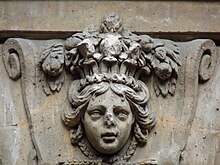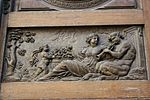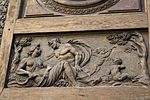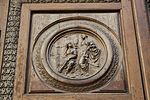Hotel Amelot de Bisseuil
The Hôtel Amelot de Bisseuil , also known as the Hôtel des Ambassadeurs de Hollande , is a Hôtel particulier in Paris . It was built in the 17th century in the Marais district, in what is now the 4th arrondissement , and is bordered by Rue Guillemites (formerly Rue des Singes) and Rue Vieille du Temple . The entrance is at 47 Rue Vieille du Temple. The nearest metro station is Saint-Paul on line 1 .
The Hôtel Amelot de Bisseuil was added to the list of French architectural monuments in 1924 as Monument historique .
history
On the site of today's Hôtel Amelot de Bisseuil, an aristocratic palace, the Hôtel de Rieux, was built in the 14th century. In the 17th century it came into the possession of Denis Amelot de Chaillou, Maître des requêtes . Around 1650 he commissioned the architect Pierre Cottard to rebuild the building, which was completed under his son, Jean-Baptiste Amelot de Bisseuil, between 1657 and 1660. After the death of his daughter, the Hôtel particulier was sold and subsequently changed hands several times.
Since 1749 the building has been known as the Hôtel des Ambassadeurs de Hollande , although there was no embassy of the United Netherlands in Paris at the time . The name could have originated from the fact that it was rented to a Dutch envoy and the Protestant chaplain, Maurice Guitton, who lived there until 1727, read masses according to the Reformed liturgy in the chapel, which is no longer preserved . After the revocation of the Edict of Nantes , Protestant services were only allowed in the buildings of foreign representations, whose chapels soon turned out to be too small.
In 1760 Louis Le Tellier († 1785) acquired the Hôtel particulier. He made major alterations and had the grand staircase and chapel demolished. In 1776 he rented the building to Pierre Augustin Caron de Beaumarchais , who lived there until 1788 and during this time wrote the piece La Folle Journée ou le Mariage de Figaro ( The Great Day or Figaro's Wedding ), which Mozart used as a template for his opera. Beaumarchais set up a branch of a company (Rodriguez, Hortalez & Compagnie) in the Hôtel particulier, which traded in arms and supplied the insurgents in the American Revolutionary War .
During the French Revolution , a public ballroom was housed in the former aristocratic palace . Later it was divided into shops and workshops. Mezzanines and partition walls were drawn in, and the gilding of the friezes and the decoration was partially removed and sold. The inner courtyard was defaced with fixtures.
In 1924 the engineer Paul Brenot bought the building and had it restored by the architect of the Monuments historiques , Robert Danis (1879-1949). In the 1950s, it was bought by Paul-Louis Weiller (1893–1993), an industrialist and co-founder of the aviation industry in France, who acted as a patron of the arts and welcomed famous people in the city palace. Further restoration work was carried out under the management of the Paul-Louis Weiller Foundation and under the direction of the architect Jean-François Lagneau. In 2010 the Hôtel particulier was sold by Alain Duménil to the Acanthe Développement real estate group for € 38 million .
architecture
Exterior construction
The entrance portal was designed by the sculptor Thomas Regnaudin (1622–1706). Two seated families are depicted on the tympanum , two Medusa heads on the two door leaves , above angels with heraldic cartouches and allegorical figures framed by medallions . The tympanum on the inside of the portal depicts how the shepherd Faustulus finds the twins Romulus and Remus , who are suckled by a she-wolf. The inside of the door leaves are also decorated with reliefs of allegorical figures.
The main building of the first inner courtyard, the courtyard of honor , has a passage on the ground floor, which is laterally surrounded by pilasters that support a balcony with a stone balustrade . The facade is crowned by a triangular gable supported by four atlases with children's heads. The pediment is occupied by two putti holding a cartouche in which the coat of arms of Amelot de Bisseuil was once carved. On the facades of the two side pavilions, sundials are painted on four panels in grisaille . They come from the mathematician and Carmelite Father Jean Truchet (1657–1729, Père Sébastien). The walls of the passage are divided by arcades and decorated with reliefs and busts in the style of antiquity.
The north wall of the second inner courtyard is provided with Corinthian pilasters and a blind arcade , the arched area of which is decorated with a relief with the allegorical representation of the arts and the theater. The facade of the west wing has a rich decor and is decorated with sculptures set in niches, depictions of virtues , and mascarons over the windows. In the middle it is crowned by a gable on which four putti hold a heraldic cartouche. The passage on the ground floor leads to Rue des Guillemites. On the ground floor of the south wing were once outbuildings housed the carriages. On the floor above there is a wide balcony, which is closed off by a wrought iron grille.
inner space
In some rooms, the decor of the former aristocratic palace has been preserved and has been restored. Doors and wood paneling of the no longer preserved rooms as well as the sculptural decoration of the former staircase were partly installed in other rooms.
The Galerie de Psyché (Galerie des Psyche) is furnished with Corinthian pilasters, elaborate door and window frames and numerous sculptures on the walls and ceiling. The ceiling and wall paintings are by Jean-Baptiste Corneille (1649–1695).
In the former bedroom ( Chambre à l'Italienne ), the ceiling has been preserved, which is designed as a dome and on which there is a painting depicting the wedding of Heracles with Hebe .
literature
- Yvan Christ, Jacques Silvestre de Sacy, Philippe Siguret: Le Marais . Henri Veyrier, Paris 1974, ISBN 2-85199-117-5 , pp. 196-202.
- Jean Colson, Marie-Christine Lauroa (ed.): Dictionnaire des Monuments de Paris . Paris 2003 (1st edition 1992), ISBN 2-84334-001-2 , pp. 39-40.
- Pierre Kjellberg: Le Guide du Marais . La Bibliothèque des Arts, Paris 1967, pp. 98-99. (without ISBN)
Web links
- Hôtel des Ambassadeurs de Hollande (Hôtel Amelot de Bisseuil) in the Base Mérimée of the French Ministry of Culture (French)
- Hôtel des Ambassadeurs de Hollande / Hôtel Amelot de Bisseuil in Structurae (French)
- Ce palais du Marais en passe d'être vendu Article in Le Parisien , published on July 6, 2010
- Historic Parisian Hotel Offered for Sale Article by Jean Rafferty, published on 23 March 2009 in the New York Times (English).
Individual evidence
- ^ Marie-Henry-Robert Danis picture index of art and architecture
- ↑ Paul-Louis Weiller ( Memento of the original from August 14, 2014 in the Internet Archive ) Info: The archive link was automatically inserted and not yet checked. Please check the original and archive link according to the instructions and then remove this notice. Saffron Museum (French)
- ↑ Un hôtel particulier du Marais, vendu 38 millions d'euros La Vie Immo on October 22, 2010
- ↑ Photos in Base Mérimée
Coordinates: 48 ° 51 '29.6 " N , 2 ° 21' 28.3" E









